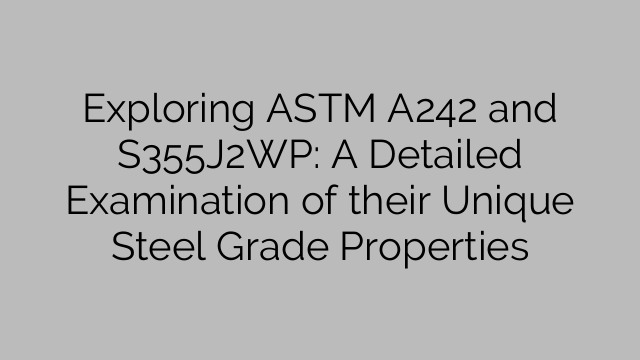ASTM A242 and S355J2WP are two steel grades commonly used in construction and industrial applications. These grades offer unique properties that make them suitable for various engineering purposes. In this article, we will explore the characteristics and advantages of both steel grades, providing a detailed examination of what sets them apart.
ASTM A242 is a high-strength, low-alloy structural steel grade that is widely used in applications where corrosion resistance is needed. This steel grade is primarily used for welded, bolted, or riveted construction projects, such as bridges, buildings, and other structures exposed to atmospheric conditions.
One of the standout features of ASTM A242 is its enhanced atmospheric corrosion resistance. It contains copper and other alloying elements, which form a protective oxide layer on the steel surface, preventing further corrosion. This property makes it highly suitable for outdoor structures, as it can withstand the harsh effects of rain, sun, snow, and other environmental factors.
Furthermore, ASTM A242 exhibits excellent weldability, making it easier and more cost-effective to work with, especially during fabrication processes like welding, bending, and cutting. Its high-strength properties also provide structural integrity and durability, allowing it to withstand heavy loads and harsh weather conditions.
On the other hand, S355J2WP is a weathering steel grade known for its superior corrosion resistance. This steel grade is primarily used in areas where exposure to the elements is unavoidable, such as marine environments, coastal regions, and areas with high humidity.
S355J2WP is characterized by the chemical composition of its alloying elements, such as copper, chromium, nickel, and phosphorus. These elements react with oxygen in the air to form a dense and adherent patina-like layer on the steel surface, which acts as a protective barrier against further corrosion. This self-protecting property eliminates the need for additional protective coatings or maintenance, making it a cost-effective and low-maintenance choice for outdoor structures.
Apart from its excellent corrosion resistance, S355J2WP also offers high yield strength and good mechanical properties. This makes it suitable for heavy-duty applications, such as bridge construction, railway projects, and architectural components that require both strength and durability.
Both ASTM A242 and S355J2WP offer unique benefits, but they also have their limitations. While these steel grades provide excellent corrosion resistance, they may not be suitable for environments with extreme conditions, such as highly acidic or alkaline environments. In such cases, stainless steel or specialized alloys might be more appropriate.
In conclusion, ASTM A242 and S355J2WP are two steel grades that offer enhanced corrosion resistance, making them ideal for outdoor and exposed applications. Their unique properties, such as high-strength, low-alloy composition, and self-protecting patina-like layers, make them popular choices in the construction and industrial sectors. By understanding the specific characteristics of each grade, engineers and architects can make informed decisions when selecting the appropriate steel grade for their projects, ensuring structural integrity, longevity, and cost-effectiveness.

